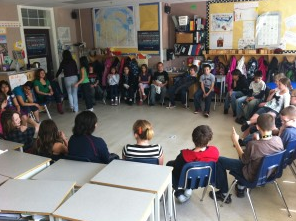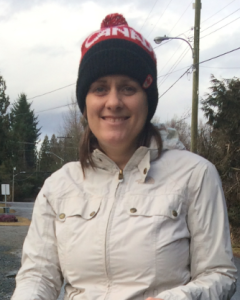The following post is by Suzanne Bartel, a grade 4/5 teacher at Cheam Elementary School in Chilliwack, British Columbia, Canada. She has been doing restorative practices in her classroom for four years and says that this year three of six classes in her school are using RP with the other three classes showing great interest. To enhance her already experienced practice, Suzanne recently attended four days of Basic Restorative Practices professional development offered by IIRP Canada and wrote this post afterwards.
“Because of our class circles, students accepted more responsibility for their roles in both creating and solving the problems. It became much easier to encourage students to solve their problems themselves; in part because I gained more confidence that students had the skills to do so, but also in part because of how the project shifted the way I communicate with my students.”
 Each morning, after the bell goes, my students arrive to my class, drop off their bags, and start rearranging the desks and chairs. By the time the second bell rings, they’ve created a circle with enough chairs for all the community members in our class, even the ones who might arrive late. They sit in the circle talking excitedly about their families, video games, pets, and everything else under the sun, while I take attendance and collect any homework or forms. As I arrive and sit down, the chatter starts to die down. Without waiting for silence, I ask who would like to be our circle keeper. The class falls dead silent as hands shoot up. I pick a student who used to be too anxious to speak in class, but now eagerly looks at me with anticipation to be chosen. I’m not sure how he’ll make out with this role, but I am not concerned. I know the circle will support him in his journey. This is a safe place for him to experiment with finding his voice.
Each morning, after the bell goes, my students arrive to my class, drop off their bags, and start rearranging the desks and chairs. By the time the second bell rings, they’ve created a circle with enough chairs for all the community members in our class, even the ones who might arrive late. They sit in the circle talking excitedly about their families, video games, pets, and everything else under the sun, while I take attendance and collect any homework or forms. As I arrive and sit down, the chatter starts to die down. Without waiting for silence, I ask who would like to be our circle keeper. The class falls dead silent as hands shoot up. I pick a student who used to be too anxious to speak in class, but now eagerly looks at me with anticipation to be chosen. I’m not sure how he’ll make out with this role, but I am not concerned. I know the circle will support him in his journey. This is a safe place for him to experiment with finding his voice.
Restorative practices have completely changed my classroom community. I always had the intention to create a safe community where students felt connected and supported. I know that this is the only type of community that will foster learning and growth. But I never had a purposeful or intentional way to create this. I just hoped that somehow my "charming" personality would develop the ideals in my head into reality. Little did I know the process I would use would end up having so little to do with me.
After our initial check in, where the students share how they are feeling and some of the things going on in their lives, I ask the class how things are going with the "name calling" issue that has been causing problems in our community. A couple of kids raise their hands and name certain individuals who have been making noticeable improvement in this area. This inspires more students to join in, "Bobby is working harder at being a team player in gym," "Kerry hasn’t called me names on the bus in the last two weeks," "Tommy has been working hard at being respectful during the eating period" – the positive vibe is overwhelming.
After the conversation is obviously coming to a close, I ask if there is anything thing else we need to be focusing on to help our community grow stronger. One boy raises his hand, "I need to work on not calling out in class all the time," and this leads to several students giving him suggestions on how he can improve on this. This inspires several other students to mention things they’d like to work on.
We wrap up the circle, I had only spoken 3-4 different times, and almost an hour has passed. Each of my students have reflected on their own growth, given feedback to their peers, practiced powerful listening and speaking skills, used their empathy skills, and connected just a little bit more with the members of their community. This was an hour well spent.
 Teacher Suzanne BartelRestorative practices is a way of being in a classroom. It inspires relationships and community. Ideally, it is student led with teacher guidance. It tackles problems head on and allows the students to work on solving these problems by making amends with the people they have impacted. We no longer have a set of class rules, but rather some expectations in how we treat each other during circle. It never takes long before these expectations reach far beyond the circle and into every aspect of the classroom – not because I say they should, but because the students begin to see how they fit into their lives outside of circle. Restorative practices move away from traditional forms of punishment, and take each individual student into account, trying to help them learn to restore the relationships in their own life and grow through challenges.
Teacher Suzanne BartelRestorative practices is a way of being in a classroom. It inspires relationships and community. Ideally, it is student led with teacher guidance. It tackles problems head on and allows the students to work on solving these problems by making amends with the people they have impacted. We no longer have a set of class rules, but rather some expectations in how we treat each other during circle. It never takes long before these expectations reach far beyond the circle and into every aspect of the classroom – not because I say they should, but because the students begin to see how they fit into their lives outside of circle. Restorative practices move away from traditional forms of punishment, and take each individual student into account, trying to help them learn to restore the relationships in their own life and grow through challenges.
This week I had the amazing opportunity to attend the International Institute of Restorative Practices [Basic Restorative Practices] workshop in Coquitlam, BC. It gave me an opportunity to reflect on my own practice and to become inspired by new ideas I could take back with me. It also gave me the opportunity to learn alongside like minded educators that value similar things as me. It’s inspired me to extend my own learning in this area through connecting with colleagues locally and globally. In my school district, I meet with a group of teachers once a month to discuss our use of restorative practices in our classrooms. Recently, I’ve been working with a colleague on creating an online community for educators using restorative practices. I would love to see a stronger online community develop around supporting each other on our personal journeys in the classroom using restorative practices. Please get in touch with me if this is also your desire!
This post originally appeared at Suzanne Bartel's blog. You may connect with her via twitter, This email address is being protected from spambots. You need JavaScript enabled to view it. or at the Restorative Classroom Google community.

